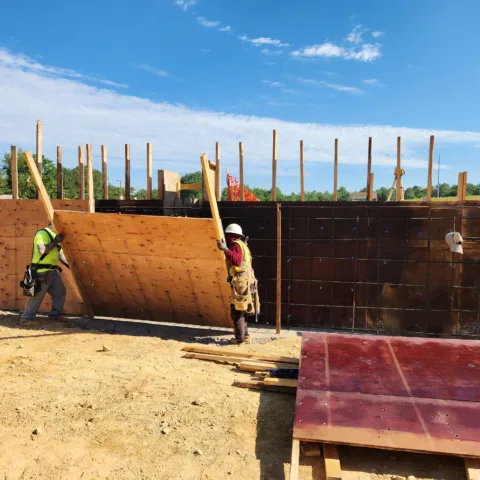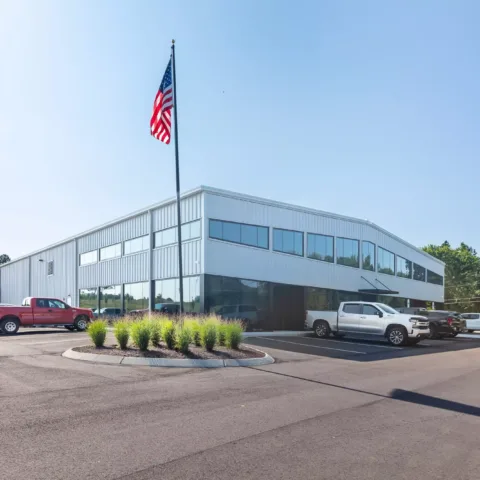Precision, collaboration, communication, and proactive planning are a few of the key factors for commercial preconstruction. At Crain, we’ve found that technology and preconstruction software can help with tasks such as scheduling, estimating, and document management. These digital tools allow our team to identify concerns or issues ahead of time and prevent problems in the field where it can be much more costly to experience delays or overlapping schedules.
While the people on our team and our relationships with industry partners will always be the most crucial component in our approach to preconstruction, technology plays a helpful role in supporting our work. We are always trying to find ways to improve efficiency and accuracy.
How Preconstruction Technology Has Evolved Over the Years
As a construction firm with nine decades of experience and an executive leadership team that has worked together for more than 20 years, we’ve navigated all the ways that technology and preconstruction have evolved over the years. We remember the days when estimates were printed on green-bar paper and quantity takeoffs were manually printed on actual blueprints!
Today, things look a little different. Takeoffs progressed from digitizers to on-screen lists to BIM models. We don’t actually need physical blueprints anymore. As technology evolved, we adapted our processes to streamline operations, improve communication, and lead to more successful project outcomes.
5 Tools and Software for Preconstruction Planning
Here are just a few of the software tools and technology we use for preconstruction planning on our commercial construction projects:
1. Estimating and Takeoff Tools
Effective cost-estimating is one of the most critical elements of preconstruction.
In construction, a takeoff is the process contractors use to determine the exact quantity of materials needed for a specific project. This is the first step in completing an estimate. Generating an accurate count of materials before submitting a bid is critical. Otherwise, you could end up overpaying for materials and cutting into your profit.
Today, there are a variety of tools that allow our preconstruction team to generate accurate and detailed takeoff lists and cost estimates. These tools even factor in the most up-to-date information on material costs, labor rates, and market fluctuations.
2. Building Information Modeling (BIM) Software
Building Information Modeling (BIM) software is a powerful tool many architects and contractors use to improve efficiency, accuracy, and collaboration. In the operations side of construction, BIM is becoming increasingly expected of contractors on projects of specific sizes and complexities. This is because BIM can help improve construction operations’ efficiency and safety.
At Crain, we also utilize BIM in much of our preconstruction work. The key difference between a BIM and other modeling tools is that a BIM file is much more information-rich and includes details of performance characteristics, specifications, and other non-physical data embedded in a shared 3-D digital model for the project.
3. Bid Management Software
There are always numerous internal stakeholders involved when putting together a bid for a new commercial construction project. Bid management software allows our team to establish coverage and coordinate efforts by collaborating on a bid in real time so all stakeholders have access to the latest information. It also guarantees that all bids comply with industry standards and that all necessary information is included.
Collaboration with suppliers, trade partners, and subcontractors is also an essential component of preconstruction. Our bid management software lets our subcontractors and suppliers know what projects we’re bidding on and ensures we have proper coverage for the scope of work involved.
4. Site Analysis Tools
Analyzing potential site challenges is one of the most helpful preconstruction questions to ask before a project. Site analysis software can help to identify potential problems and risks before construction begins. These tools can be used to collect and analyze data about the site, such as topography, soil conditions, and existing utilities. They can also create 3D models of the site, which can be used to visualize the project and identify potential conflicts.
5. Project Management and Collaboration Software
Maximizing value and minimizing costs is one of the key principles of preconstruction. Project management software and collaboration tools can be beneficial when starting a project and often lead to a smoother and more efficient construction process. Whether it’s sharing information with project owners who live out-of-state or tracking tasks to identify potential delays, these digital tools help our preconstruction team improve accuracy, efficiency, decision-making, and risk management.
Set Your Project Up For Success Before The First Shovel Hits the Ground
At Crain, everything we do is designed to help build relationships and structures that last a lifetime. Our preconstruction team plays a significant role in helping us maximize the potential success of a project and establish a solid partnership with clients before the construction process begins.
Want to learn more about our approach or have questions about your next project? Reach out to our team today.



